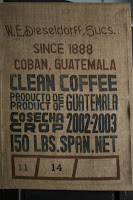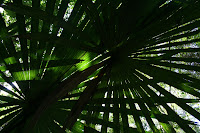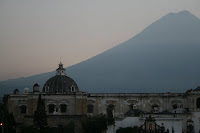
Tikal. The fabled Maya ruins of a lost city, buried deep in the jungle, just waiting to be explored.
Such a risky adventure out into the unknown required stolid, dependable companions and who better, as the locals keep reminding us, to accompany me than someone called Lara.
And for good measure we recruited a third, an idiosyncratic potter from North Wales called Rik, a former climatologist and devoted ‘raw fooder’.
I was anticipating great things. We’d visited jungles before on this trip, discovering their hidden splendours both natural (Khao Yai national park, Thailand) and manmade (the temples of Angkor, Cambodia.
Tikal however, offers both, combining to make it surely one of the most enticing destinations on the planet.
Once a huge Mayan city, Tikal was a highly complex society, rivalling and, in some cases, outstripping its European contemporaries, both in size and sophistication.
Its inhabitants made impressive advances in a whole range of fields, including science, mathematics and - perhaps most importantly to the Maya - astronomy.
In its own environs, Tikal was a was a regional superpower; more often than not gaining the upper hand in the many regional wars fought between cities vying for power, managing to dominate the Peten region for 500 years.
However, it still shared with them a common fate when, around 900 AD, like the rest of the entire Maya civilisation Tikal suddenly and mysteriously collapsed.
For reasons unknown its inhabitants abruptly upped and left. Gone. The whole city abandoned and left for the jungle to reclaim.
Soon the great temples and mighty plazas become overgrown, and the whole city began to disappear under a tide of the organic matter from which it had once sprang.
Today the ruins can be visited, spread over an enormous site where the visitor can turn Indiana Jones or Lara Croft, seeking out ruins where falling walls are covered in moss and crumpled masonry sprouts trees.
We had a go ourselves, attempting to decipher glyphs and stelae etched with fearsome-looking squat fellows decked out in feathered headresses, and scaling the great temples, mighty pyramids of limestone which rise up to poke their gnarled heads up through the forest canopy.
Ascending Temple V I discovered a new-found fear of heights, my knees a-knocking, my stomach churning.
As I gripped the rails of the near-vertical wooden staircase I tried not to think about the several tourists who have tumbled to their deaths over the years; as I inched along the narrow ledges at the top I marvelled at quite how the Maya could have climbed up the single, sheer flight of steps, which lay crumbling away below us.
Back down on the ground fear soon turned to wonder as we entered the Acropolis; an involuntary ’wow’ spilling from my lips as I gazed upon the Grand Plaza.
Ahead lay Temple I, resting place of the splendidly-titled King Moon Double Comb AKA Lord Chocolate.
It was the only temple to have been fully clawed back from the jungle, so much of this huge site remains to be discovered, with wonders both manmade and natural.
In the fragile balance between the two worlds, since the fall of the city the natural world has been back in the ascendancy and all around you cannot fail to be amazed.
The ruins themselves sit in the middle of a national park, an oasis of biodiversity, with hundreds of species of trees, plants, birds and animals.
The trees were extraordinary, coming in all shapes and sizes, from delicate little palms to massive soaring monsters.
 Strange flossy-like fronds hung off slender trucks, whilst neighbouring titans stretched out their enormous buttress roots across the jungle floor like some kind of monstrous arboreal callisthenics.
Strange flossy-like fronds hung off slender trucks, whilst neighbouring titans stretched out their enormous buttress roots across the jungle floor like some kind of monstrous arboreal callisthenics.Some of them, like the Ceiba tree, rivalled the very temples in both scale and splendour. This tree was revered by the ancient Maya as the ‘holy tree of life’; growing up to 70 metres in height, with a trunk up to two metres thick I could see how they considered it to be ‘the axle of the world’.
Monkeys danced through the treetops, hightailing it through the branches, Agile spider monkeys leapt from tree to tree, bellicose howler monkeys hollered testily at a group of pastel-suited French tourists below.
We gave the latter a wide berth, the lessons learned from an encounter with a troupe of howlers the day before. That group, infuriated at our encroachment into their territory, subjected to a dual assault of terrifying cacophony and aerial bombardment, defecating upon us and going - quite literally - ‘apeshit.’
Other creatures awaited us: coatimundi, strange long-nosed creatures with prehensile tails investigating the contents of rubbish bins; tubby coatis, patrolling the small clearings; and even the odd crocodile, poking its sharp snout out of a pond.
Away from the human visitors, well off the jungle paths, dwelt a rich range of other exotic creatures: jaguars, armadillos, tapirs and snakes.
In the dawn light the forest canopy vibrated to the song of a thousand bird calls, and as the day entered we spotted some of these mysterious menagerie.
High up hawks and eagles patrolled the blue sky and vultures wheeled around on the lookout for carrion. Below them keel-billed toucans called and parakeets screeched as they passed over the forest canopy.
Beneath the treetops lineated woodpeckers hammered out a steady drum while, lower down, tiny hummingbirds flitted incessantly from flower to flower.
Down on the jungle floor, a great currasow scurried out of the bushes behind us while up ahead a gaggle of oscillated turkeys strutted along, scurrying to the edges as we passed through them on the narrow path.
Great armies of leafcutter ants strode across the forest floor, highly-organised creatures who leave a clearly defined path in their wake, a miniature M40 corridor along which they transport freshly-cut leaves.
 It was extraordinary to watch these dogged little insects, overcoming all manner of hazards and determinedly shouldering their load, many times their own size, all the way back to base.
It was extraordinary to watch these dogged little insects, overcoming all manner of hazards and determinedly shouldering their load, many times their own size, all the way back to base.Other insects proved less enamouring, tarantulas for example, to which I came rather too close to for comfort.
In the dim dawn light I left the john, sauntering across a stretch of ground, blithely whistling ‘Sheila take a bow’, completing oblivious to the enormous hairy arachnid which I’d come within an inch of stepping on.
The beast must have been at least the size of my hand and surely capable of devouring it.
With such creatures in abundance it hard to concentrate on the manmade wonders. That was of course, until we came across the Tower IV. Bland name, incredible place.
From 64 metres up, on top of this crumbling edifice we looked out across the forest canopy, stretching as far as the eye can see. A spellbinding sight.
It must have been hundreds of miles, our perch a mere pinprick in an ocean of green. The only sign of human existence was a few crumbling towers in the near distance, knocking on for 2000 years old.
The remains of a lost civilisation, mankind trumped by nature.
It was a moment when you realise the insignificance of man in the face of the unstoppable power of the natural world.
It was hard not to draw parallels between the lost world of the ancient Maya and our own. Population crisis, competition over scant resources, climate change.
Rik proved particularly knowledgeable on the latter. He pulled out another enormous carrot and, as he gnawed on it, he pointed out that all mankind was doing was merely speeding up the process, the planet all set, as before, for a major change in climate in a few thousand years.
Adroit scientists and astronomers the Maya believed the earth ‘lived’ in cycles of some 5,128 years. Theirs, and ours is the third ‘earth’, a world that is due to end in 2012 ( just in time for the London Olympics).
Baloney or not it set me thinking about the future. My mind turned to home and I imagined some future tourist seeking out the ruins of our lost civilisation, pulling the creepers back from the remains of the Weatherspoons down our road, stubbing their toe on the collapsed lintel of Finsbury Park tube station.
Wantage in a deep freeze (would it make any difference?); the dreaming spires of Oxford under water. The world come full circle.
2012's not long off: better get that stadium finished sharpish.
Read more...






























